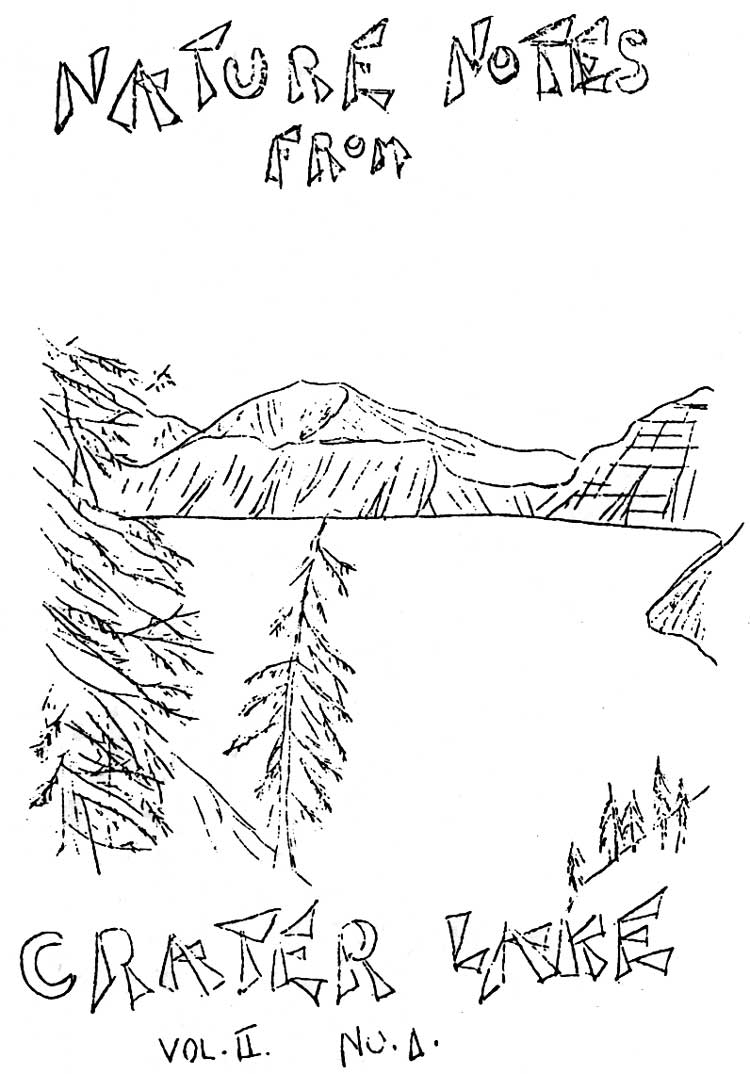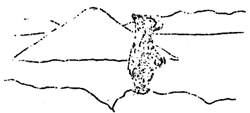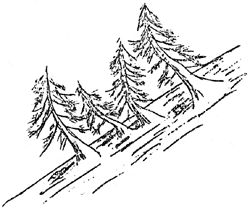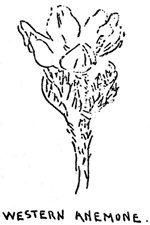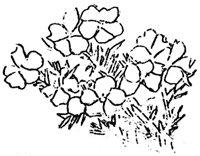
Volume 2 No. 1 – July 1, 1929All material courtesy of the National Park Service. These publications can also be found at http://npshistory.com/Nature Notes is produced by the National Park Service. © 1928. |
The staff of the Educational Division in Crater Lake National Park has been increased this year, to afford greater service to the Public, and also to leave more permanent record of the work accomplished.
Mr. Dale Leslie, of Eugene, Oregon, has been assigned as Ranger-Naturalist. Miss Mabel Hibbard, who has had several years of experience in the Yosemite, is in active charge of the Temporary Museum. Mr. Fredrick L. Wynd is assisting especially in the preparation of material for the Manual of Information.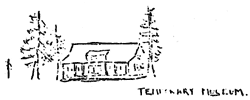
The Temporary Museum in the Community House is rapidly developing into a focus of interest for the Public. A relief model of the Park has been added, together with temporary cases to contain the bird specimens prepared by Dr. Loye Miller, and the insect and rock collections which are being rapidly increased. The cut-flower collection numbers over sixty identified species. Many valuable exhibits are awaiting the construction of a more permanent building.
A Fish Story
By Earl U. Homuth
Originally there were no fish in Crater Lake. Hundreds of thousands have been planted during past years, but even tho a planting is an event of interest, the original planting by William G. Steel in 1888, will always serve as the best fish story from Crater Lake.
Late in August 1888, Mr. Steel with a companion was driving over the old road to the Lake. They stopped for the night at the cabin of Mr. Gordon, on the Rogue River, forty-nine miles from the Lake. During the evening Mr. Steel casually asked whether it might be possible to get some trout fingerlings from the river to stock the Lake. Old Mr. Gordon ‘lowed as how “My boys kin ketch some for you.”
Next morning Steel forgot about the fish and was about to drive away when Mr. Gordon said that they boys were waiting to see him. Behind the cabin the boys had an old home-made tub, and it was swarming with minnows. Steel was considerably taken aback, because he had casually offered ten cents apiece for the fish and the boys had caught hundreds of them. Gathering his courage he asked what they would take for the tubfull, and the older boy answered that they’d figured four-bits would be about right! Steel gladly gave them each a new silver dollar.
Steel then dipped out a bucket full of water and fish, estimating that there were at least six hundred fingerlings in the bucket. A mosquito netting was tied over the top and the bucket was placed in the wagon. At the first lurch of the wagon the water splashed from the bucket and Steel jumped out of the wagon, refilled it and then started out ahead and walked forty-nine miles to Crater Lake, bucket in hand. At each stream he stopped, dug a hole in the sand, and when the pool cleared, placed the bucket in the water to allow fresh water to flow into the bucket.
The evening of the first day the party camped at Whiskey Creek, thirty-five miles from the Lake. The bucket was placed in the stream for the night. On the second day, late in the afternoon they came to the Rim of the Lake. Steel set the bucket on the ground to prepare camp. Presently, the fish began to roll over. He noticed this and quickly picking up the bucket hurried down the inner slope of the Rim, as rapidly as safety permitted, and arriving at the Lake, plunged the bucket into the water. He removed the mosquito netting and awaited results. Gradually a few fish revived and righted themselves, and swam over the edge of the bucket. Steel counted them and the first planting of Crater Lake was accomplished with thirty-seven rainbow trout.*
* As told by William G. Steel to Earl U. Homuth.
An Orphan
By Earl U. Homuth
A helpless young marmot was found by Ranger Crogan wandering beside the road near Anna Springs camp. Two large black ants had attached themselves to its nose and their grip was so determined that a pocket knife was necessary to remove them. Possibly those enemies had driven the little fellow in desperation from its nest. At present the orphan is doing nicely at Headquarters, receiving considerable personal attention.
Spring Slides on Talus Slopes
By L. D. Leslie, Ranger-Naturalist
During the noon hour on July first, Park Headquarters at Crater Lake was engulfed in a cloud of dust. This dust originated from a rock slide on an adjacent talus slope. Slides of this sort may be expected on any talus slope soon after the disappearance of the winter’s snow which covers them. The reason for rock movement on such a talus slope is made clear when one recalls the fact that water expands upon freezing. The water from the heavy early winter rains soon fills the small interspaces of the loose talus rock material and upon solidification forces the rock upward in a vertical manner from its horizontal plane. In the early spring when thawing begins the frozen water again condenses and the raised rock materials are lowered but not along the same verticals in which they were raised. This is due to the fact that their center of gravity has been changed in reference to their previous position before being raised by the frozen waters. As a result of this new position of gravity now extends a force along a new vertical which will cause the rock to fall toward the foot of the mountain. This downward movement of the rock from its first resting places may be slight. Nevertheless, it may have been sufficient to place a number of loose rocks in a precarious position so that a rock-slide could easily be started on the talus slope.
Our Bears
By Earl U. Homuth
Last year our bears returned to their usual haunts around Headquarters so late in the summer that for a time it was feared they had left us for other regions. This year there is no question as to their whereabouts.
Jemima (the former Jimmy), who first appeared about the 1st of June, wanders down to the mess house each evening. She is alone this year, as her husky cubs of last season are shifting for themselves.
A yearling cub became so intimate with the “bug crew”, which has been working on pine bark beetle eradication, that several men have had to spend lunchless days in the forest. Lunches are now suspended from the ends of small branches.
Another yearling has been developing the habit of begging or demanding food from tourists entering on the Medford road. He is reported by those coming in on this road nearly every day.
Hans, Fritz, and others of those known personally to the rangers have been reported, so this season we will undoubtedly not miss the interest that bears create.
The Fruiting Bodies of Slime Molds
By Frederick L. Wynd
In the earlier part of the season during the time when the snow is melting in the deep woods just below the Rim, the fruiting bodies of the slime molds may be found in great numbers on the ground and on rotten logs. They are usually about one-half inch in diameter and are bright orange in color which makes them very conspicuous and easily identified. The spores are borne in great numbers in the interior of the mass.
The great group of slime molds are among the most interesting plants in existence, and their strange life history should be more commonly known. During certain stages they show the characteristics of animals, and in other stages they appear as typical plants.
In the evolutionary scheme of things in which we regard the plants and animals as having a common ancestry, we would expect to find forms of life which are not clearly differentiated into either. The slime molds are among these “missing links” that connect the two great classes of life.
Identity?
By C. L. Croghan, Park Ranger
While putting things away for the winter at Anna Springs last November, a young pine squirrel was noticed, very busily engaged in stowing away his winter supply of pine cones. On closer observation it was discovered that this squirrel had different markings than the ordinary pine squirrel. It was thought possible that this could be due to its immaturity.
This summer it was again observed working around various trees and dwellings. The body is more slim than that of the ordinary pine squirrel of the Castle Creek area. The coat, while of about the same color on the back, is distinctly a more golden brown underneath. The tail has a white tip rather than the usual black; and the fur along the edges of the tail is of grayish color instead of brown and black.
Tree Curvature
By L. D. Leslie, Ranger-Naturalist
A majority of the trees growing on the steep moraines of old Mount Mazama have a pronounced curvature at their base. So prominent is this bending that many tourists wonder at the phenomenon.
The Early Flowers
By Frederick L. Wynd
The early blooming flowers are usually small and inconspicuous. This may be because they are generally those species that rely largely on the food which they have stored during the previous season. Food which has been so carefully hoarded over the winter is not to be wasted in producing needlessly large plant bodies. If one is observant, however, he may even at this early part of the season find an abundant number of species in bloom.
The following list has been identified from near the Rim and Government Camp before July 1st, and these are the species which the tourist may expect to see at this time of the year:
Clintonia uniflora (Schult.) Kunth.
Vagnera amplexicaulis (Nutt.) Greene.
Limnorchis stricta (Lindl.) Rydb.
Limnorchis dilatata (Pursh) Rydb.
Salix sitchensis Sanson
Salix eastwoodiae Cockerell
Salix scouleriana Barratt
Alnus sinuata (Regel) Rydb.
Eriogonum umbellatum Torr.
Polygonum newberryi Small
Spraguea umbellata Torr.
Claytonia lanceolata Pursh
Anemone drummondii Wats.
Pulsatilla occidentalis (Wats.) Froyn.
Ranunculus gormanii Greene
Ranunculus eschscholtzii Schlecht.
Bicuculla formosa (Andr.) Coville
Bicuculla uniflora (Kellogg) Howell
Parrya menziesii (Hook.) Greene
Ribes erythrocarpum Cov. & Leiberg
Ribes cereum Dougl.
Ribes viscosissimum Pursh
Ribes lacustre (Pers.) Poir.
Potentilla glandulosa Lindl.
Prunus emarginata (Dougl.) Walp.
Amelanchier florida Lindl.
Ceanothus prostratus Benth.
Ceanothus velutinus Dougl.
Viola purpurea Kellogg
Viola glabella Nutt.
Viola praemorsa Dougl.
Arctostaphylos nevadensis Greene
Arctostaphylos patula Greene
Kalmia glauca microphylla Hook.
Vaccinium scoparium Leiberg
Vaccinium membranaceum Dougl.
Phlox douglasii Hook.
Polemonium viscosum elegans
Lapulla diffusa (Lehm.) Greene
Valeriana sitchensis Bong.
Agoseris alpestris (Gray) Greene
Other pages in this section

